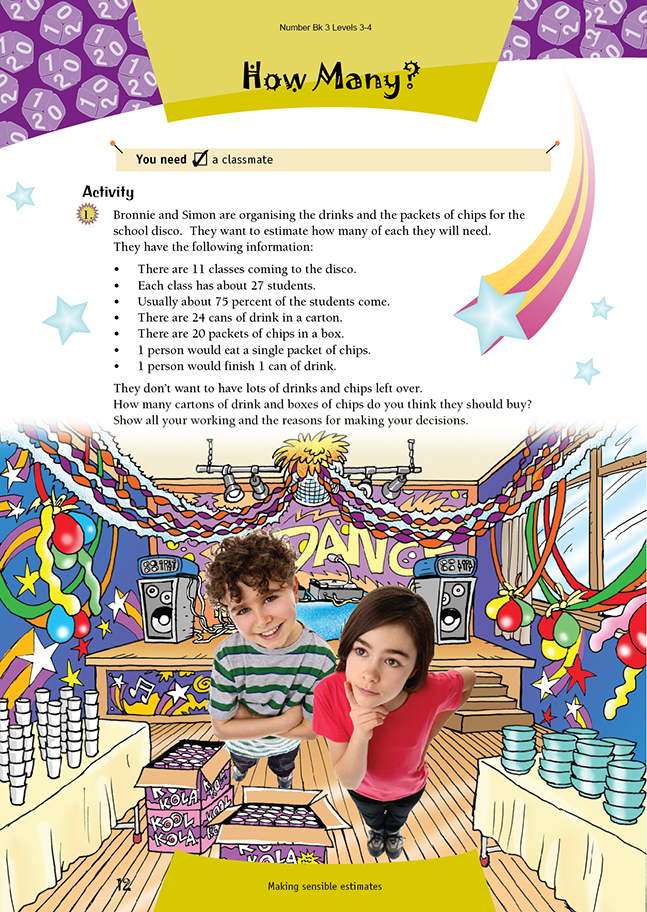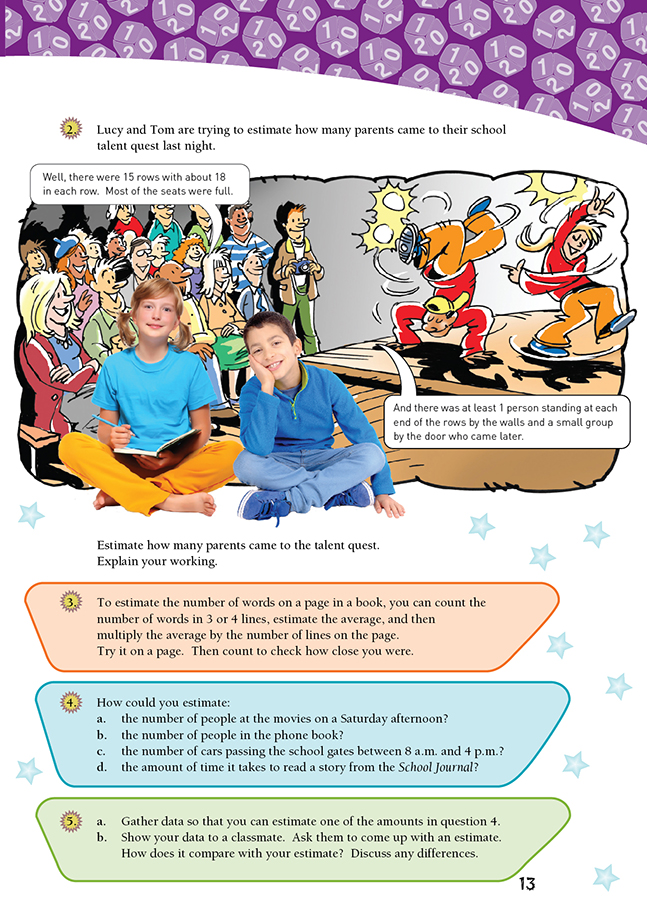This is a level 4 number activity from the Figure It Out series. It relates to Stage 7 of the Number Framework.
A PDF of the student activity is included.
Click on the image to enlarge it. Click again to close. Download PDF (727 KB)
make estimates to solve multiplication problems
FIO, Level 3-4, Number, Book 3, How Many, pages 12-13
A classmate
The questions in this activity are all designed to help students develop their estimation skills using a range of data and taking into account various possibilities. Estimation strategies with respect to number include rounding up or down to reasonably close numbers that can be manipulated mentally. The estimates required in this activity involve multiplication and division. The activity is therefore suitable for students at the advanced additive stage or beyond of the Number Framework.
You could discuss with the students when and why they might estimate rather than calculate exactly. Estimating is useful when an exact calculation isn’t required or, as in the case of the food for the school disco in question 1, when it’s not possible to calculate exactly because there is no exact data to work with. (The two students don’t know how many people will come to the disco or how much they will eat and drink.) Estimating is often quicker than calculating, especially when you don’t have a calculator handy. You could ask the students to compile a class list of situations in
which estimating is useful.
See the Answers section for the thinking behind the possible answers for question 1.
Question 2 is a problem that can be tackled initially in a similar way to finding the area of a rectangle, that is, by multiplying the number of rows (if you like, the length) by the approximate number of people in each row (if you like, the width). In this case, it means multiplying 15 by 18. This can be calculated mentally in several different ways, for example, (10 x 18) + 5 x (20 – 2), which is 180 + 100 – 10, giving 270. A different strategy is given in the Answers. Another possible strategy
is to use doubling and halving (15 x 18 = 30 x 9), then known multiplication facts (3 x 9) and multiplication by 10. Obviously, several valid estimates are possible for this problem, depending on how the data is interpreted.
The students could use a variety of advanced multiplicative part–whole strategies to estimate the number of words on a page in question 3. For example, if the page had 30 lines with an average of 17 words per line, they could use:
• standard place value: 30 x 17 = (30 x 10) + (30 x 7)
= 300 + 210
= 510
• tidy numbers: 30 x 17 = (30 x 20) – (30 x 3)
= 600 – 90
= 510
or 30 x 17 = (30 x 15) + (30 x 2)
= 450 + 60
= 510
Some possible estimation strategies for questions 4a–d are given in the Answers. The students could discuss other strategies that they think of with a classmate.
In question 5b, the students are asked to collect data and compare their own estimates with a classmate’s. There are various reasons why estimates can vary. For example, different students could well read the same School Journal story at different rates and thus arrive at different estimates, all of which could be valid.
Answers to Activity
1. Answers will vary. For example: 11 classes of 27 is approximately 10 classes of 30 students = 300. If 75% come, that’s 3/4 of 300; 1/2 would be 150, and 1/4 must be 75, so 3/4 would be 225. Most would have a drink and chips, so they’ll
need about 225 of each. 200 is 10 lots of 20, so 225 is 11 or 12 boxes of chips. 24 is about 25, so that’s 9 or 10 cartons of drinks. (It’s probably better to go for the higher figure in each case.)
2. Answers will vary. For example, 10 rows is about 180, and 5 rows is about 90, so that’s about 270. Add 30 for the one or more at the ends of rows, so that’s now about 300. Not all the rows were full, but there could have been 10 standing by
the door. So the total estimate could be between 300 and 315.
3. Answers will vary.
4. Answers will vary. For example:
a. Multiply the average number of people in each row by the number of rows.
b. Count the number of entries in a column. Multiply by the number of columns in a page and then multiply by the number of pages in the phone book.
c. Count the number of cars going past in 1 minute during the rush hour of 8 a.m. to
9 a.m. and multiply this number by 60 to get the number that could go by in the hour.
Then count the number of cars going past in 1 minute after 9 a.m. and extrapolate this
for the rest of the school day. The number of cars between 3 p.m. and 4 p.m. could
increase significantly, so you may decide to regard this period as another rush hour.
d. Time how long it takes to read 1 page with a reasonable number of words on it. Multiply this by the number of pages.
5. Answers will vary.

